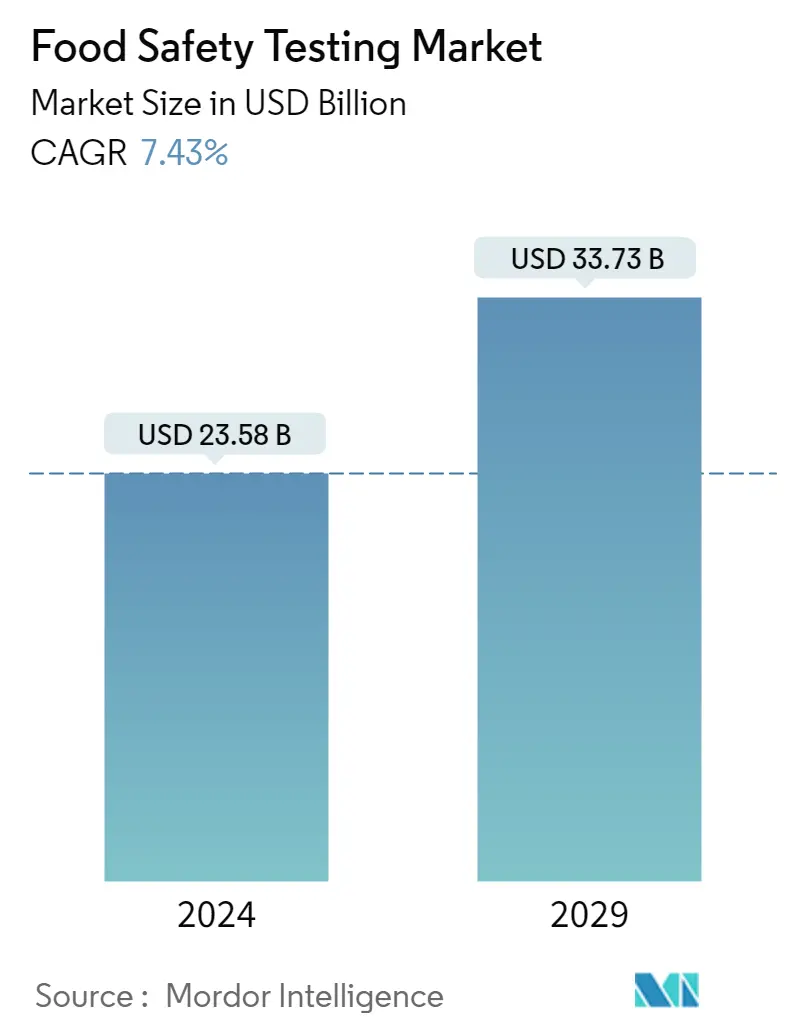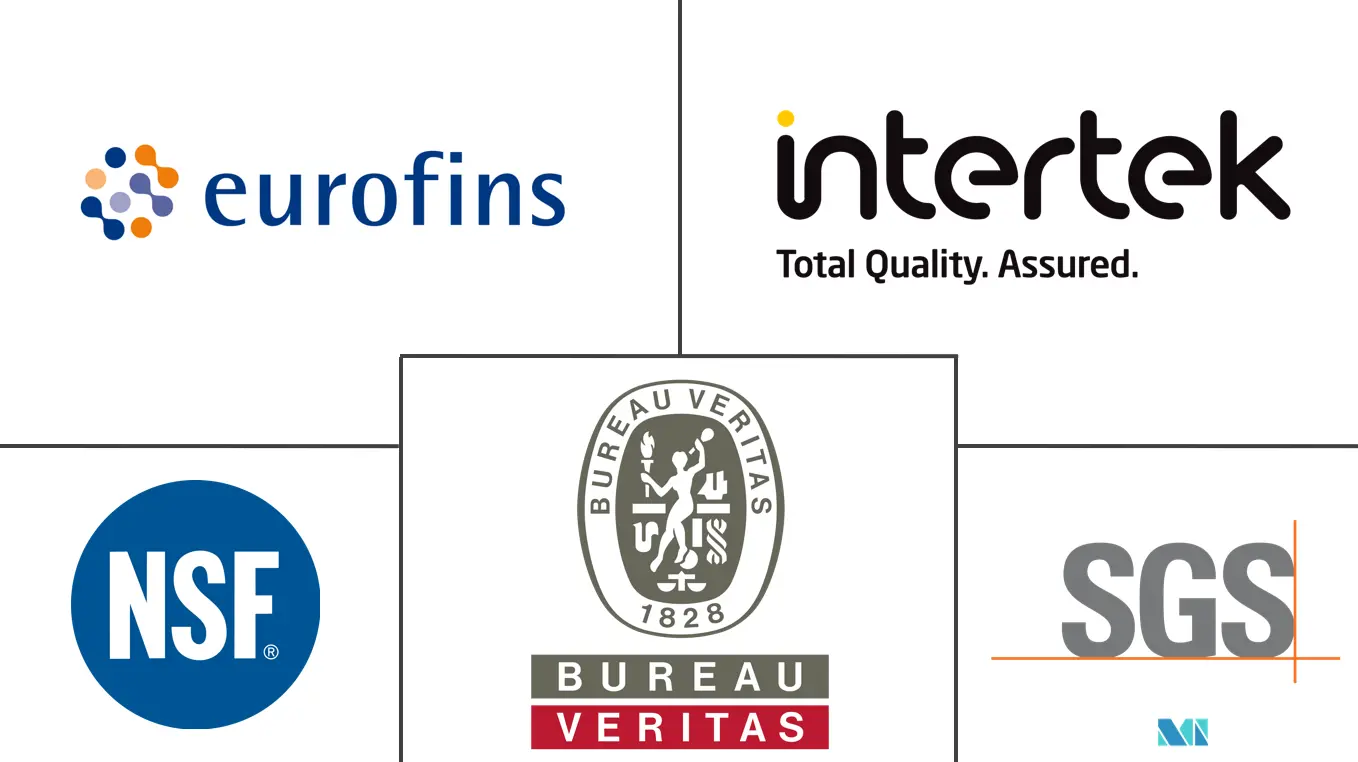Market Size of Food Safety Testing Industry

| Study Period | 2019 - 2029 |
| Market Size (2024) | USD 23.58 Billion |
| Market Size (2029) | USD 33.73 Billion |
| CAGR (2024 - 2029) | 7.43 % |
| Fastest Growing Market | Middle East and Africa |
| Largest Market | Europe |
Major Players
*Disclaimer: Major Players sorted in no particular order |
Food Safety Testing Market Analysis
The Food Safety Testing Market size is estimated at USD 23.58 billion in 2024, and is expected to reach USD 33.73 billion by 2029, growing at a CAGR of 7.43% during the forecast period (2024-2029).
Widespread foodborne infections, food adulteration, and other factors threatening public health are prompting local governments and concerned authorities to impose stringent rules. This factor has led to a growth in food safety testing in packaged, processed, and other raw materials, such as vegetables and fruits, which fuelled the growth of the market.
Customers' increasing intolerance to allergens, such as gluten and dairy, is leading to allergy-free product advances worldwide. This has subsequently led to the introduction of allergy-free products, often tested by manufacturers for allergens and trace particles in packaged and processed food products. Chemical testing in organic products is growing in popularity in the market, owing to companies operating throughout the world testing these products for evidence of listed or banned chemicals to comply with various country-level regulatory agencies. The European Union, for example, maintains a list of over 500 chemicals and hazardous compounds that must be removed from organic products shipped to European countries.
The market's growth was further propelled over the past few years by the COVID-19 pandemic, a factor which led to the increased testing of food products to curb the spread of the virus.
Food Safety Testing Industry Segmentation
Food safety testing is a scientific procedure that assesses food safety based on its microbiological, physical, or chemical composition. The food business has devised a set of food safety testing protocols to ensure the safety of the food supply. The global food safety testing market (henceforth, referred to as the market studied) is segmented by contaminant testing, technology, application, and geography. By contaminant testing, the market is segmented into pathogen testing, pesticide and residue testing, mycotoxin testing, GMO testing, allergen testing, and other containment testing. By technology, the market is segmented into immunoassay-based, chromatography and spectrometry (which is further segmented into HPLC-based, LC-MS/MS-based, and other chromatography and spectrometry), and other technologies. Based on application, the market studied is segmented into animal feed and pet food, and food. The food segment is further sub-segmented into meat and poultry, dairy, fruits and vegetables, processed food (which is further segmented into baby food, bakery products, savory and sweet snacks, and dietary supplements), crops, and other foods. It provides an analysis of emerging and established economies across the world, comprising North America, Europe, South America, Asia-Pacific, and Middle East and Africa. For each segment, the market sizing and forecasts have been provided based on value (in USD million).
| Contaminant Testing | |
| Pathogen Testing | |
| Pesticide and Residue Testing | |
| Mycotoxin Testing | |
| GMO Testing | |
| Allergen Testing | |
| Other Contaminant Testing |
| Technology | |||||
| Polymerase Chain Reaction (PCR) | |||||
| Immunoassay-based | |||||
| |||||
| Other Technologies |
| Application | |||||||||||||
| Animal Feed and Pet Food | |||||||||||||
|
| Geography | |||||||||
| |||||||||
| |||||||||
| |||||||||
| |||||||||
|
Food Safety Testing Market Size Summary
The food safety testing market is experiencing significant growth, driven by increasing public health concerns related to foodborne infections and adulteration. This has led to stricter regulations imposed by local governments and authorities, boosting the demand for testing across various food categories, including packaged, processed, and raw materials like fruits and vegetables. The rising consumer intolerance to allergens such as gluten and dairy has spurred the development of allergy-free products, which are rigorously tested for allergens and trace particles. Additionally, the popularity of chemical testing in organic products is on the rise, as companies strive to meet the stringent requirements set by regulatory agencies worldwide, such as the European Union's extensive list of banned chemicals. The COVID-19 pandemic further accelerated the need for food safety testing, as it highlighted the importance of ensuring high-quality food to prevent the spread of the virus.
The market is characterized by intense competition, with numerous regional and multinational companies vying for market share. Leading players like Eurofins Scientific, SGS SA, ALS Limited, Bureau Veritas Group, and Intertek dominate the landscape, investing heavily in research and development to maintain their competitive edge. These companies are expanding their operations globally, as evidenced by Eurofins' strategic acquisitions and facility expansions in the United States and Mexico. In regions like the Middle East and Africa, food and beverage companies, along with government bodies, are enhancing food safety assurances to build consumer trust. The South African market, in particular, has seen growth driven by pathogen testing and increased scrutiny of chemical and toxin levels in food products. Overall, the food safety testing market is poised for continued expansion, fueled by technological advancements and growing consumer awareness of food quality and safety issues.
Food Safety Testing Market Size - Table of Contents
-
1. MARKET DYNAMICS
-
1.1 Market Drivers
-
1.2 Market Restraints
-
1.3 Porter's Five Forces Analysis
-
1.3.1 Threat of New Entrants
-
1.3.2 Bargaining Power of Buyers/Consumers
-
1.3.3 Bargaining Power of Suppliers
-
1.3.4 Threat of Substitute Products
-
1.3.5 Intensity of Competitive Rivalry
-
-
-
2. MARKET SEGMENTATION
-
2.1 Contaminant Testing
-
2.1.1 Pathogen Testing
-
2.1.2 Pesticide and Residue Testing
-
2.1.3 Mycotoxin Testing
-
2.1.4 GMO Testing
-
2.1.5 Allergen Testing
-
2.1.6 Other Contaminant Testing
-
-
2.2 Technology
-
2.2.1 Polymerase Chain Reaction (PCR)
-
2.2.2 Immunoassay-based
-
2.2.3 Chromatography and Spectrometry
-
2.2.3.1 HPLC Based
-
2.2.3.2 LC-MS/MS-Based
-
2.2.3.3 Other Chromatography and Spectrometry
-
-
2.2.4 Other Technologies
-
-
2.3 Application
-
2.3.1 Animal Feed and Pet Food
-
2.3.2 Food
-
2.3.2.1 Meat and Poultry
-
2.3.2.2 Dairy
-
2.3.2.3 Fruits and Vegetables
-
2.3.2.4 Processed Food
-
2.3.2.4.1 Baby Food
-
2.3.2.4.2 Bakery Products
-
2.3.2.4.3 Savory and Sweet Snacks
-
2.3.2.4.4 Dietary Supplements
-
-
2.3.2.5 Crops
-
2.3.2.6 Other Foods
-
-
-
2.4 Geography
-
2.4.1 North America
-
2.4.1.1 United States
-
2.4.1.2 Canada
-
2.4.1.3 Mexico
-
2.4.1.4 Rest of North America
-
-
2.4.2 Europe
-
2.4.2.1 United Kingdom
-
2.4.2.2 Germany
-
2.4.2.3 France
-
2.4.2.4 Russia
-
2.4.2.5 Italy
-
2.4.2.6 Spain
-
2.4.2.7 Rest of Europe
-
-
2.4.3 Asia-Pacific
-
2.4.3.1 India
-
2.4.3.2 China
-
2.4.3.3 Japan
-
2.4.3.4 Australia
-
2.4.3.5 Rest of Asia-Pacific
-
-
2.4.4 South America
-
2.4.4.1 Brazil
-
2.4.4.2 Argentina
-
2.4.4.3 Rest of South America
-
-
2.4.5 Middle East & Africa
-
2.4.5.1 South Africa
-
2.4.5.2 Saudi Arabia
-
2.4.5.3 Rest of Middle East & Africa
-
-
-
Food Safety Testing Market Size FAQs
How big is the Food Safety Testing Market?
The Food Safety Testing Market size is expected to reach USD 23.58 billion in 2024 and grow at a CAGR of 7.43% to reach USD 33.73 billion by 2029.
What is the current Food Safety Testing Market size?
In 2024, the Food Safety Testing Market size is expected to reach USD 23.58 billion.

